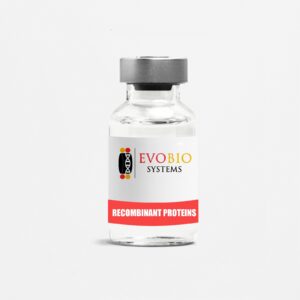Showing 118–126 of 142 results
-
Recombinant Human BRAF (N-GST tag)
Product Details
Gene ID N/A Accession NM_004333 Alternative Name BRAF (Ex9-18), BRAF1, RAFB1, B-raf, B-raf 1, MGC126806, MGC138284 Species Human Source Insect cells Description BRAF is a member of the RAF family that is activated by members of the Ras family upon growth factor-induced stimulation. Active Ras can induce heterodimerization of cRaf and BRAF and this may explain the observed cooperativity of cRaf and BRAF in cells responding to growth factor signals . Activating mutations in the BRAF gene are present in a large percentage of human malignant melanomas and in a proportion of colon cancers. The vast majority of these mutations result in a valine to glutamic acid change at residue 599 within the activation segment of BRAF . Accession NM_004333 Functions The specific activity of BRAF was determined to be 2,300 nmol/min/mg in a coupled assay as per activity assay protocol. Formulation 50mM Tris-HCl, pH 7.5, 150mM NaCl, 10mM glutathione, 0.1mM EDTA, 0.25mM DTT, 0.1mM PMSF, 25% glycerol. Solubility N/A Appearance Liquid Molecular Weight 69 Purity 70% – 90% Shipping Condition Dry Ice Storage Condition Store product at ?70?C. For optimal storage, aliquot target into smaller quantities after centrifugation and store at recommended temperature. For most favorable performance, avoid repeated handling and multiple freeze/thaw cycles. $0.00(No) -
Recombinant Human BRAF (N-GST tag)
Product Details
Gene ID N/A Accession NM_004333 Alternative Name BRAF1, RAFB1, B-raf 1, MGC126806, MGC138284 Species Human Source Insect cells Description BRAF is a member of the RAF family that is activated by members of the Ras family upon growth factor-induced stimulation. Active Ras can induce heterodimerization of cRaf and BRAF and this may explain the observed cooperativity of cRaf and BRaf in cells responding to growth factor signals . Activating mutations in the BRAF gene are present in a large percentage of human malignant melanomas and in a proportion of colon cancers. The vast majority of these mutations result in a valine to glutamic acid change at residue 599 within the activation segment of B-RAF . Accession NM_004333 Functions The specific activity of BRAF was determined to be 74 nmol /min/mg as per activity assay protocol, using MEK1 as substrate. Formulation 50mM Tris-HCl, pH 7.5, 150mM NaCl, 0.25mM DTT, 0.1mM EGTA, 0.1mM EDTA, 0.1mM PMSF, 25% glycerol. Solubility N/A Appearance Liquid Molecular Weight 63 Purity 70% – 90% Shipping Condition Dry Ice Storage Condition Store product at ?70?C. For optimal storage, aliquot target into smaller quantities after centrifugation and store at recommended temperature. For most favorable performance, avoid repeated handling and multiple freeze/thaw cycles. $0.00(No) -
Recombinant Human BRK (N-GST tag)
Product Details
Gene ID N/A Accession NM_005975 Alternative Name PTK6; FLJ42088 Species Human Source Insect cells Description ?BRK is a member of the non-receptor tyrosine kinases (PTKs) that contains an amino terminal SH3 and SH2 domain as well as the catalytic domain . BRK expression is low or undetectable in normal mammary tissue and benign lesions. However, approximately two-thirds of breast tumors express appreciable levels, and 27% of tumors over express BRK by fivefold or more .? Accession NM_005975 Functions The specific activity of BRK was determined to be 133 nmol /min/mg as per activity assay protocol. Formulation 50mM Tris-HCl, pH 7.5, 150mM NaCl, 0.25mM DTT, 0.1mM EGTA, 0.1mM EDTA, 0.1mM PMSF, 25% glycerol. Solubility N/A Appearance Liquid Molecular Weight 80 Purity 70% – 90% Shipping Condition Dry Ice Storage Condition Store product at ?70?C. For optimal storage, aliquot target into smaller quantities after centrifugation and store at recommended temperature. For most favorable performance, avoid repeated handling and multiple freeze/thaw cycles. $0.00(No) -
Recombinant Human BRSK2 (N-GST tag)
Product Details
Gene ID N/A Accession NM_003957 Alternative Name HUSSY-12, C11orf7; PEN11B; SAD1; STK29 Species Human Source Insect cells Description BRSK2 is a brain-selective serine/threonine kinase 2 that is mainly expressed in the brain, with weaker expression in testis and pancreas. BRSK2 expressed in insect cells specifically phosphorylates WEE1A, CDC25C and CDC25B in an in vitro assay. DNA damage induced by ultraviolet (UV) irradiation or methyl methane sulfonate, but not by ionizing radiation, enhanced endogenous BRSK2 kinase activity in a caffeine-sensitive manner and caused translocation of BRSK2 from the cytoplasm to the nucleus . Overexpression of BRSK2 induces G2/M arrest in HeLa cells while small interfering RNA against BRSK2 partly abrogated UV-induced G2/M arrest. Mammalian BRSK2 kinases are required for neuronal polarization . Accession NM_003957 Functions The specific activity of BRSK2 was determined to be 105 nmol /min/mg as per activity assay protocol. Formulation 50mM Tris-HCl, pH 7.5, 150mM NaCl, 10mM glutathione, 0.1mM EDTA, 0.25mM DTT, 0.1mM PMSF, 25% glycerol. Solubility N/A Appearance Liquid Molecular Weight 108 Purity 70% – 90% Shipping Condition Dry Ice Storage Condition Store product at ?70?C. For optimal storage, aliquot target into smaller quantities after centrifugation and store at recommended temperature. For most favorable performance, avoid repeated handling and multiple freeze/thaw cycles. $0.00(No) -
Recombinant Human BTK (N-His tag)
Product Details
Gene ID N/A Accession NM_000061 Alternative Name AT; ATK; BPK; XLA; IMD1; AGMX1; PSCTK Species Human Source Insect cells Description BTK (also known as Bruton tyrosine kinase) plays a crucial role in B-lymphocyte differentiation and activation. BTK interacts with SRC homology 3 domains of FYN, LYN and HCK that are activated upon stimulation of B- and T-cell receptors . Defects in the BTK gene cause Agammaglobulinemia, an X-linked immunodeficiency characterized by failure to produce mature B lymphocyte cells and associated with a failure of Ig heavy chain rearrangement. The unique role of BTK makes it a desirable target for potential anti-cancer, anti-inflammatory and anti-viral agents as well as other treatments .? Accession NM_000061 Functions The specific activity of BTK was determined to be 43 nmol /min/mg as per activity assay protocol. Formulation 50mM NaPhosphate, pH7.0, 300mM NaCl, 150mM imidazole, 0.1mM PMSF, 0.2mM DTT, 25% glycerol. Solubility N/A Appearance Liquid Molecular Weight 78 Purity 70% – 90% Shipping Condition Dry Ice Storage Condition Store product at ?70?C. For optimal storage, aliquot target into smaller quantities after centrifugation and store at recommended temperature. For most favorable performance, avoid repeated handling and multiple freeze/thaw cycles. $0.00(No) -
Recombinant Human CAMK1 delta (N-GST tag)
Product Details
Gene ID N/A Accession NM_153498 Alternative Name RP11-462F15.1; CKLiK; CaM-K1; CaMKID Species Human Source Insect cells Description CAMK1d or Ca2+/calmodulin-dependent kinase I-like kinase (CKLiK) is activated by Ca(2+) and calmodulin and is detected in CD34+-derived neutrophils and eosinophils, as well as in mature peripheral blood granulocytes . CAMK1d exhibits Ca(2+)/CaM-dependent activity that is enhanced in vitro by phosphorylation of its Thr180 by CaM-K kinase (CaM-KK)alpha, consistent with detection of CAMK1D-activating activity in HeLa cells . Accession NM_153498 Functions The specific activity of CAMK1d was determined to be 138 nmol /min/mg as per activity assay protocol. Formulation 50mM Tris-HCl, pH 7.5, 150mM NaCl, 0.25mM DTT, 0.1mM EGTA, 0.1mM EDTA, 0.1mM PMSF, 25% glycerol. Solubility N/A Appearance Liquid Molecular Weight 68 Purity 70% – 90% Shipping Condition Dry Ice Storage Condition Store product at ?70?C. For optimal storage, aliquot target into smaller quantities after centrifugation and store at recommended temperature. For most favorable performance, avoid repeated handling and multiple freeze/thaw cycles. $0.00(No) -
Recombinant Human CAMK1 gamma (1-330aa) (N-GST tag)
Product Details
Gene ID N/A Accession NM_020439 Alternative Name VWS1; CLICKIII; dJ272L16.1 Species Human Source Insect cells Description CAMKI? (CLICK-III), a member of CAMK family, is a novel membrane-anchored neuronal Ca2+/calmodulin-dependent protein kinase. Full activation of CaMKI? requires both Ca(2+)/CaM and phosphorylation by CAMKK. CAMKI? transcripts is most abundant in neurons, with the highest levels in limited nuclei such as the central nucleus of the amygdala (CeA) and the ventromedial hypothalamus .? Accession NM_020439 Functions The specific activity of CAMK1? was determined to be 788 nmol /min/mg as per activity assay protocol Formulation 50mM Tris-HCl, pH 7.5, 150mM NaCl, 0.25mM DTT, 0.1mM EGTA, 0.1mM EDTA, 0.1mM PMSF, 25% glycerol. Solubility N/A Appearance Liquid Molecular Weight 69 Purity 70% – 90% Shipping Condition Dry Ice Storage Condition Store product at ?70?C. For optimal storage, aliquot target into smaller quantities after centrifugation and store at recommended temperature. For most favorable performance, avoid repeated handling and multiple freeze/thaw cycles. $0.00(No) -
Recombinant Human CAMK1 gamma (N-GST tag)
Product Details
Gene ID N/A Accession NM_020439 Alternative Name VWS1; CLICKIII; dJ272L16.1 Species Human Source Insect cells Description CAMKI? (CLICK-III), a member of CAMK family, is a novel membrane-anchored neuronal Ca2+/calmodulin-dependent protein kinase. Full activation of CaMKI? requires both Ca(2+)/CaM and phosphorylation by CAMKK. CAMKI? transcripts is most abundant in neurons, with the highest levels in limited nuclei such as the central nucleus of the amygdala (CeA) and the ventromedial hypothalamus . Accession NM_020439 Functions The specific activity of CAMK1? was determined to be 820 nmol /min/mg as per activity assay protocol. Formulation 50mM Tris-HCl, pH 7.5, 150mM NaCl, 10mM glutathione, 0.1mM EDTA, 0.25mM DTT, 0.1mM PMSF, 25% glycerol. Solubility N/A Appearance Liquid Molecular Weight 80 Purity 70% – 90% Shipping Condition Dry Ice Storage Condition Store product at ?70?C. For optimal storage, aliquot target into smaller quantities after centrifugation and store at recommended temperature. For most favorable performance, avoid repeated handling and multiple freeze/thaw cycles. $0.00(No) -
Recombinant Human CAMK2 alpha (N-GST tag)
Product Details
Gene ID N/A Accession NM_171825 Alternative Name CAMKA; KIAA0968 Species Human Source Insect cells Description CAMK2a is a ser/thr protein kinase that is a member of the Ca2+/calmodulin-dependent protein kinase family. CAMK2a is abundant in the brain as a major constituent of the postsynaptic density and is required for hippocampal long-term potentiation (LTP) and spatial learning. In addition to its Ca2+/calmodulin-dependent activity, CAMK2a can undergo autophosphorylation, resulting in Ca2+/calmodulin-independent activity. The protein level of CAMK2a fluctuates during neuronal activity in cultured rat pup hippocampal neurons. The levels of CAMK2a increased with heightened neuronal activity .? Accession NM_171825 Functions The specific activity of CAMK2a was determined to be 256 nmol /min/mg as per activity assay protocol. Formulation 50mM Tris-HCl, pH 7.5, 150mM NaCl, 0.25mM DTT, 0.1mM EGTA, 0.1mM EDTA, 0.1mM PMSF, 25% glycerol. Solubility N/A Appearance Liquid Molecular Weight 74 Purity 70% – 90% Shipping Condition Dry Ice Storage Condition Store product at ?70?C. For optimal storage, aliquot target into smaller quantities after centrifugation and store at recommended temperature. For most favorable performance, avoid repeated handling and multiple freeze/thaw cycles. $0.00(No)






